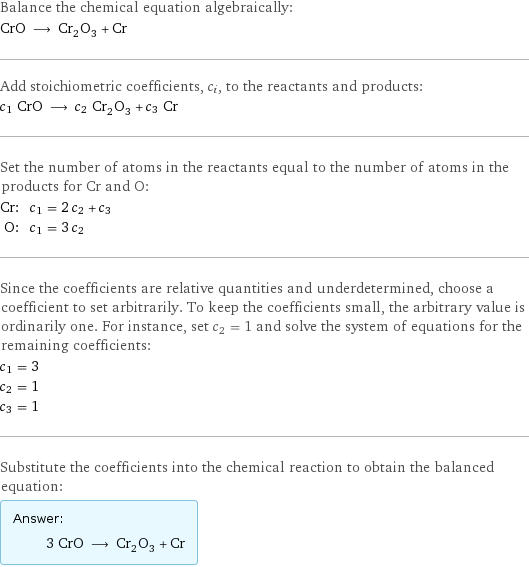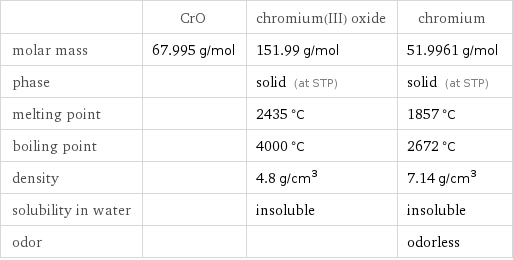Input interpretation

CrO ⟶ Cr_2O_3 chromium(III) oxide + Cr chromium
Balanced equation

Balance the chemical equation algebraically: CrO ⟶ Cr_2O_3 + Cr Add stoichiometric coefficients, c_i, to the reactants and products: c_1 CrO ⟶ c_2 Cr_2O_3 + c_3 Cr Set the number of atoms in the reactants equal to the number of atoms in the products for Cr and O: Cr: | c_1 = 2 c_2 + c_3 O: | c_1 = 3 c_2 Since the coefficients are relative quantities and underdetermined, choose a coefficient to set arbitrarily. To keep the coefficients small, the arbitrary value is ordinarily one. For instance, set c_2 = 1 and solve the system of equations for the remaining coefficients: c_1 = 3 c_2 = 1 c_3 = 1 Substitute the coefficients into the chemical reaction to obtain the balanced equation: Answer: | | 3 CrO ⟶ Cr_2O_3 + Cr
Structures

CrO ⟶ +
Names

CrO ⟶ chromium(III) oxide + chromium
Equilibrium constant
![Construct the equilibrium constant, K, expression for: CrO ⟶ Cr_2O_3 + Cr Plan: • Balance the chemical equation. • Determine the stoichiometric numbers. • Assemble the activity expression for each chemical species. • Use the activity expressions to build the equilibrium constant expression. Write the balanced chemical equation: 3 CrO ⟶ Cr_2O_3 + Cr Assign stoichiometric numbers, ν_i, using the stoichiometric coefficients, c_i, from the balanced chemical equation in the following manner: ν_i = -c_i for reactants and ν_i = c_i for products: chemical species | c_i | ν_i CrO | 3 | -3 Cr_2O_3 | 1 | 1 Cr | 1 | 1 Assemble the activity expressions accounting for the state of matter and ν_i: chemical species | c_i | ν_i | activity expression CrO | 3 | -3 | ([CrO])^(-3) Cr_2O_3 | 1 | 1 | [Cr2O3] Cr | 1 | 1 | [Cr] The equilibrium constant symbol in the concentration basis is: K_c Mulitply the activity expressions to arrive at the K_c expression: Answer: | | K_c = ([CrO])^(-3) [Cr2O3] [Cr] = ([Cr2O3] [Cr])/([CrO])^3](../image_source/df68392a1c4a1752f37c0acc14b3ae6c.png)
Construct the equilibrium constant, K, expression for: CrO ⟶ Cr_2O_3 + Cr Plan: • Balance the chemical equation. • Determine the stoichiometric numbers. • Assemble the activity expression for each chemical species. • Use the activity expressions to build the equilibrium constant expression. Write the balanced chemical equation: 3 CrO ⟶ Cr_2O_3 + Cr Assign stoichiometric numbers, ν_i, using the stoichiometric coefficients, c_i, from the balanced chemical equation in the following manner: ν_i = -c_i for reactants and ν_i = c_i for products: chemical species | c_i | ν_i CrO | 3 | -3 Cr_2O_3 | 1 | 1 Cr | 1 | 1 Assemble the activity expressions accounting for the state of matter and ν_i: chemical species | c_i | ν_i | activity expression CrO | 3 | -3 | ([CrO])^(-3) Cr_2O_3 | 1 | 1 | [Cr2O3] Cr | 1 | 1 | [Cr] The equilibrium constant symbol in the concentration basis is: K_c Mulitply the activity expressions to arrive at the K_c expression: Answer: | | K_c = ([CrO])^(-3) [Cr2O3] [Cr] = ([Cr2O3] [Cr])/([CrO])^3
Rate of reaction
![Construct the rate of reaction expression for: CrO ⟶ Cr_2O_3 + Cr Plan: • Balance the chemical equation. • Determine the stoichiometric numbers. • Assemble the rate term for each chemical species. • Write the rate of reaction expression. Write the balanced chemical equation: 3 CrO ⟶ Cr_2O_3 + Cr Assign stoichiometric numbers, ν_i, using the stoichiometric coefficients, c_i, from the balanced chemical equation in the following manner: ν_i = -c_i for reactants and ν_i = c_i for products: chemical species | c_i | ν_i CrO | 3 | -3 Cr_2O_3 | 1 | 1 Cr | 1 | 1 The rate term for each chemical species, B_i, is 1/ν_i(Δ[B_i])/(Δt) where [B_i] is the amount concentration and t is time: chemical species | c_i | ν_i | rate term CrO | 3 | -3 | -1/3 (Δ[CrO])/(Δt) Cr_2O_3 | 1 | 1 | (Δ[Cr2O3])/(Δt) Cr | 1 | 1 | (Δ[Cr])/(Δt) (for infinitesimal rate of change, replace Δ with d) Set the rate terms equal to each other to arrive at the rate expression: Answer: | | rate = -1/3 (Δ[CrO])/(Δt) = (Δ[Cr2O3])/(Δt) = (Δ[Cr])/(Δt) (assuming constant volume and no accumulation of intermediates or side products)](../image_source/ee141b8145c4907ad152c618c7303c9d.png)
Construct the rate of reaction expression for: CrO ⟶ Cr_2O_3 + Cr Plan: • Balance the chemical equation. • Determine the stoichiometric numbers. • Assemble the rate term for each chemical species. • Write the rate of reaction expression. Write the balanced chemical equation: 3 CrO ⟶ Cr_2O_3 + Cr Assign stoichiometric numbers, ν_i, using the stoichiometric coefficients, c_i, from the balanced chemical equation in the following manner: ν_i = -c_i for reactants and ν_i = c_i for products: chemical species | c_i | ν_i CrO | 3 | -3 Cr_2O_3 | 1 | 1 Cr | 1 | 1 The rate term for each chemical species, B_i, is 1/ν_i(Δ[B_i])/(Δt) where [B_i] is the amount concentration and t is time: chemical species | c_i | ν_i | rate term CrO | 3 | -3 | -1/3 (Δ[CrO])/(Δt) Cr_2O_3 | 1 | 1 | (Δ[Cr2O3])/(Δt) Cr | 1 | 1 | (Δ[Cr])/(Δt) (for infinitesimal rate of change, replace Δ with d) Set the rate terms equal to each other to arrive at the rate expression: Answer: | | rate = -1/3 (Δ[CrO])/(Δt) = (Δ[Cr2O3])/(Δt) = (Δ[Cr])/(Δt) (assuming constant volume and no accumulation of intermediates or side products)
Chemical names and formulas

| CrO | chromium(III) oxide | chromium formula | CrO | Cr_2O_3 | Cr name | | chromium(III) oxide | chromium
Substance properties

| CrO | chromium(III) oxide | chromium molar mass | 67.995 g/mol | 151.99 g/mol | 51.9961 g/mol phase | | solid (at STP) | solid (at STP) melting point | | 2435 °C | 1857 °C boiling point | | 4000 °C | 2672 °C density | | 4.8 g/cm^3 | 7.14 g/cm^3 solubility in water | | insoluble | insoluble odor | | | odorless
Units
